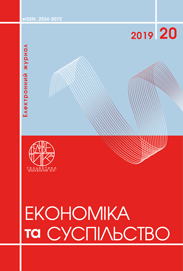INTEGRATED EVALUATION METHODS AS AN INSTRUMENT FOR REGULATION OF ECOLOGICAL-ECONOMIC COMPETITIVENESS OF REGIONS
Abstract
The article considers existing integrated and index methods of assessing the level of competitiveness of regions in terms of environmental and economic parameters. The author presents his own vision of such techniques and group them into economic content. The study presents a critical evaluation of the parameters and criteria that underpin such assessments. A feature of the study is the analysis of indicators from the point of view of managing the level of competitiveness of the regions. The objective of establishing the level of competitiveness of the regions is not only the analysis of the current state, but also the establishment of those aspects and parameters that require special attention from the controlling entities. Ecological and economic competitiveness can provide rational, socio-perspective development of the whole system of economic management of the region. Accordingly, the indicator or their aggregate that characterizes the level of such competitiveness should be comprehensive and versatile and reflect not only the general conditional development of ecological and economic characteristics, but also the directions and methods for their effective management. The most common method of determining the level of competitiveness of regions is to determine the integral indicator based on a set of parameters of socio-economic development. Accordingly, an assessment of ecological and economic competitiveness could be conducted by analogy, but provided that the components of the integral index are supplemented by environmental parameters and with the exception of non-essential. To determine the feasibility and effectiveness of such a transformation of existing techniques, we will analyze the main ones. The vast majority of integral techniques can provide users with a general idea of the level of competitiveness of the regions, but from the standpoint of its individual aspects, in particular, environmental and economic ones, are too narrow. For the purposes of management, the results of such assessments are more useful in the context of their components. Accordingly, it is from a set of parameters and indicators that is the basis of the evaluation depends on its usefulness for management purposes. As a result, the author outlines a methodology for assessing the level of ecological and economic competitiveness, which can fully meet the needs of management of it.
References
Журба І.Є. Конкурентоспроможність регіону: суть, методи оцінки, сучасний стан. Економіка підприємства. 2005. № 3. С. 45–49.
Кузьмін О.Є., Горбаль Н.І. Управління міжнародною конкурентоспроможністю підприємства : підручник. Львів: Компакт-ЛВ. 2005. 304 с.
Реутов В.Є. Міжнародна конкурентоспроможність регіону: сутність, методи оцінювання. Економіка та держава. 2006. № 4. С. 52–54.
Ковальська Л.Л. Методичні підходи до аналізу і оцінювання конкурентоспроможності регіону. Актуальні проблеми економіки. 2013. № 3(141). С. 109–124.
Безугла В.О. Аналіз конкурентоспроможності регіонів України. Регіональна економіка. 2004. № 4. С. 64–68.
Манцуров І.Г. Статистика економічного зростання та конкурентоспроможності країни : монографія. Київ : КНЕУ, 2006. 392 с.
Журба М.В. Формирование конкурентной среды региона : автореф. дис. … канд. экон. наук. Нижний Новгород, 2003. 24 с.
Мельник М.І. Інвестиційний клімат регіону: теоретичні та прикладні засади дослідження : монографія. Львів : ІРД НАН України, 2005. 304 с.
Zhurba I. (2005) Konkurentospromozhnist rehionu: sut, metody otsinky, suchasnyi stan [Competitiveness of the region: the essence, methods of evaluation, current state]. Ekonomika pidpryiemstva. Economy of the enterprise, 3, 45-49 [in Ukrainian].
Kuzmin O., Horbal N. (2005) Upravlinnia mizhnarodnoiu konkurentospromozhnistiu pidpryiemstva: Pidruchnyk. [The International Competitiveness of an Enterprise: Textbook]. Lviv: Compact-Lv [in Ukrainian].
Reutov V. (2006) Mizhnarodna konkurentospromozhnist rehionu: sutnist, metody otsiniuvannia [International Competitiveness of the Region: Essence, Methods of Evaluation]. Ekonomika ta derzhava. Economy and the State, 4, 52-54 [in Ukrainian].
Kovalska L. (2013) Metodychni pidkhody do analizu i otsiniuvannia konkurentospromozhnosti rehionu [Methodical approaches to the analysis and evaluation of the region's competitiveness]. Aktualni problemy ekonomiky. Current problems of the economy, 3(141), 109-124 [in Ukrainian].
Bezuhla V. (2004) Analiz konkurentospromozhnosti rehioniv Ukrainy [Analysis of Competitiveness of Ukrainian Regions]. Rehionalna ekonomika. Regional Economics, 4, 64-68 [in Ukrainian].
Mantsurov I. (2006) Statystyka ekonomichnoho zrostannia ta konkurentospromozhnosti krainy: Monohrafiia [Economic Growth and Competitiveness Statistics of the Country: Monograph]. K.: KNEU, 392 [in Ukrainian].
Zhurba M. (2003) Formyrovanye konkurentnoi sredy rehyona: Avtoref. dys. kand. эkon. nauk [Formation of the competitive environment of the region: Author's abstract. dis Cand. econ sciences]. Nyzhnyi Novhorod, 24 [in Russian].
Melnyk M. (2005) Investytsiinyi klimat rehionu: teoretychni ta prykladni zasady doslidzhennia: Monohrafiia [Investment climate of the region: theoretical and applied research principles: Monograph]. Lviv: IRD NAS of Ukraine, 304 [in Ukrainian].


